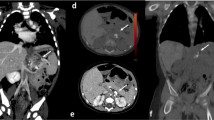Abstract
Background
Dual-energy CT technology is available on scanners from several vendors and offers significant advantages over classic single-energy CT technology in multiple clinical applications. Many studies have detailed dual-energy CT applications in adults and several have evaluated the relative radiation dose performance of dual-energy CT in adult imaging. However, little has been published on dual-energy CT imaging in the pediatric population, and the relative dose performance of dual-energy CT imaging in the pediatric population is not well described.
Objective
When evaluating dual-energy CT technology for implementation into a routine clinical pediatric imaging practice, the radiation dose implications must be considered, and when comparing relative CT dose performance, image quality must also be evaluated. Therefore the purpose of this study is to develop dual-energy CT scan protocols based on our optimized single-energy scan protocols and compare the dose.
Materials and methods
We scanned the head, chest and abdomen regions of pediatric-size anthropomorphic phantoms with contrast inserts, using our optimized single-energy clinical imaging protocols on a Siemens Flash® CT scanner. We then scanned the phantoms in dual-energy mode using matching image-quality reference settings. The effective CT dose index volume (CTDIvol) of the scans was used as a surrogate for relative dose in comparing the single- and dual-energy scans. Additionally, we evaluated image quality using visual assessment and contrast-to-noise ratio.
Results
Dual-energy CT scans of the head and abdomen were dose-neutral for all three phantoms. Dual-energy CT scans of the chest showed a relative dose increase over the single-energy scan for 1- and 5-year-old child-based age-equivalent phantoms, ranging 11–20%. Quantitative analysis of image quality showed no statistically significant difference in image quality between the single-energy and dual-energy scans. There was no clinically significant difference in image quality by visual assessment.
Conclusion
Dual-energy CT is dose-neutral in imaging the head and abdomen in children. It is not dose-neutral in chest imaging of very small children. With a better understanding of the dose consequences of converting single-energy protocols to dual-energy protocols we can begin to implement clinical dual-energy CT and utilize its unique capabilities in pediatric imaging.



Similar content being viewed by others
References
Johnson TRC (2012) Dual-energy CT: general principles. AJR Am J Roentgenol 199:3–8
Freiherr G (2015) New offerings at RSNA 2014 echo increased efficiency. Imaging technology news. http://www.itnonline.com/article/new-offerings-rsna-2014-echo-increased-efficiency. Accessed 3 May 2016
Mansouri M, Aran S, Singh A et al (2015) Dual-energy computed tomography characterization of urinary calculi: basic principles, applications and concerns. Curr Probl Diagn Radiol 44:496–500
Agrawal M, Pinho D, Kulkarni N et al (2014) Oncologic applications of dual energy CT in the abdomen. Radiograpics 34:589–611
Coupal TM, Mallinson PI, McLaughlin P et al (2014) Peering through the glare: using dual-energy CT to overcome the problem of metal artefacts in bone radiology. Skelet Radiol 43:567–575
Jiang XY, Zhang SH, Xie QZ et al (2015) Evaluation of virtual noncontrast images obtained from dual-energy CTA for diagnosing subarachnoid hemorrhage. AJNR Am J Neuroradiol 36:855–860
Schulz B, Kuehling K, Kromen W et al (2012) Automatic bone removal technique in whole-body dual-energy CT angiography: performance and image quality. AJR Am J Roentgenol 199:W646–W650
Goo HW (2010) Initial experience of dual-energy lung perfusion CT using a dual-source CT system in children. Pediatr Radiol 40:1536–1544
Zhu X, Mecca P, Servaes S et al (2014) Dual energy compared to single energy CT scans in pediatric patients: dose neutral or not? Abstract. Pediatr Radiol 44:S253
Schenzle JC, Sommer WH, Neumaier K et al (2010) Dual energy CT of the chest: how about the dose? Investig Radiol 45:347–353
Henzler T, Fink C, Schoenberg SO et al (2012) Dual-energy CT: radiation dose aspects. AJR Am J Roentgenol 199:16–25
Takeuchi M, Kawai T, Ito M et al (2012) Split-bolus CT-urography using dual-energy CT: feasibility, image quality and dose reduction. Eur J Radiol 81:3160–3165
Goo HW (2013) Dual-energy lung perfusion and ventilation CT in children. Pediatr Radiol 43:298–307
Author information
Authors and Affiliations
Corresponding author
Ethics declarations
Conflicts of interest
None
Rights and permissions
About this article
Cite this article
Zhu, X., McCullough, W.P., Mecca, P. et al. Dual-energy compared to single-energy CT in pediatric imaging: a phantom study for DECT clinical guidance. Pediatr Radiol 46, 1671–1679 (2016). https://doi.org/10.1007/s00247-016-3668-x
Received:
Revised:
Accepted:
Published:
Issue Date:
DOI: https://doi.org/10.1007/s00247-016-3668-x




